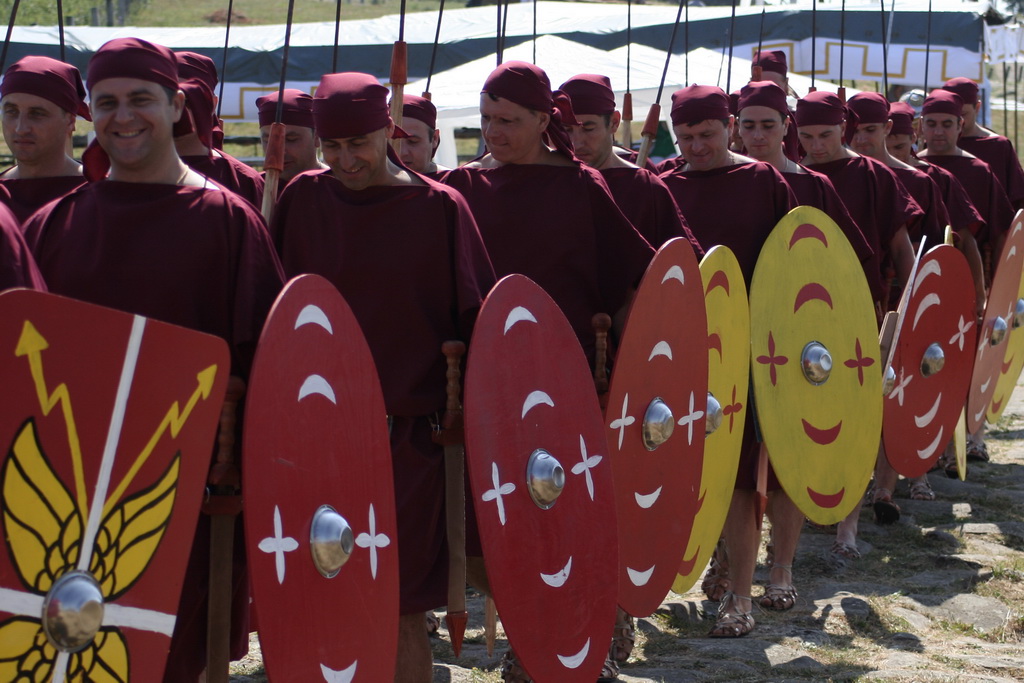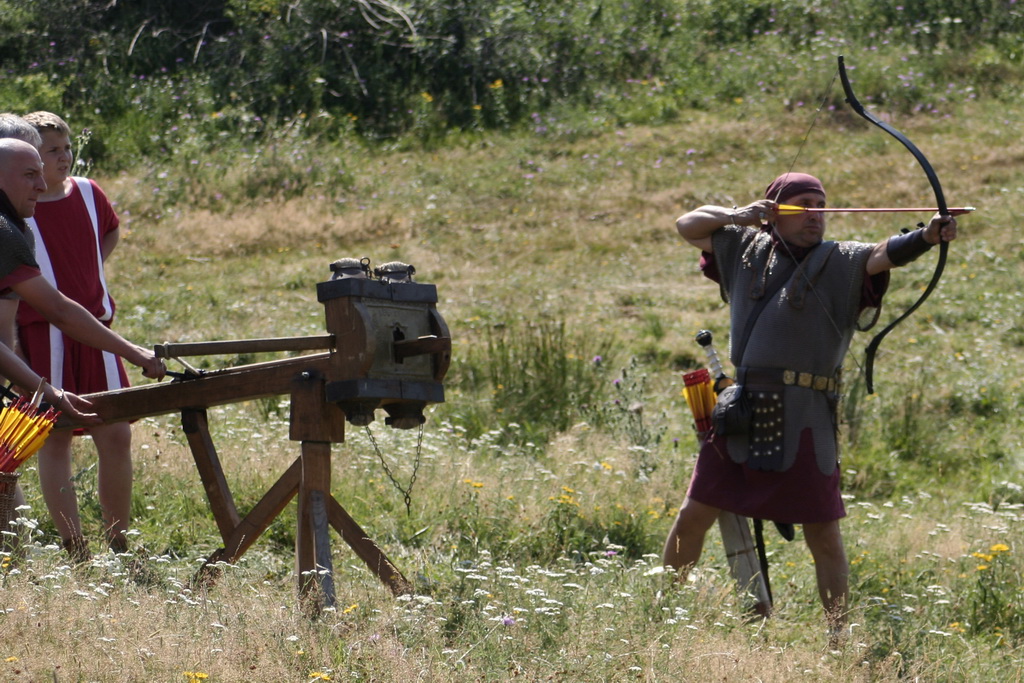History - Page 4
ROMAN ERA (2nd – 3rd century A.D.) After the defeat and the submittal of Decebal’s kingdom, the Romans used to the maximum these strategic possibilities offered by the old fortifications and roads previously made by the Dacians.
Thus, directly in the pass defended by the Dacian fortification on the Poguior Hill, the Romans built a fort of 80 x 65 m and a defending wall which blocks the entire pass, and over the Dacian fortress from Citera hill they built a fort for the specially made unit of palmyreni archers. Taking the name of the old Dacian dave from the Măgura Moigradului, Porolisso, and having as basis the tactical realities of the area as a pass, realities remarkably used by the Dacians, the Romans built here one of the most important and complex defending system known as the Porolissensis limes. At the end of the Dacian wars fom 106 A.D. summer, the Roman Empire conquered and organized as Roman province the land of the Decebal’s kingdom. In the North-West part of Dacia, on Meseş Mountain, the Romans emerged and organized the frontier (limes) which separate the area conquered by the Roman Empire, by the unconquered and unenclosed areas in the administrative unit of Dacia province, territories inhabited by free Dacians and other barbarian tribes (Sarmatians, Vandals). The Roman border – the limes – of the Roman Empire from Meseş Mountain was built of approx. 60 surveillance towers made of stone and wood. In front of the towers, on the crossing points, there were built earth and wood fortifications, with ditches, banks and defending palisades, and in the back of this line of towers and linear defending fortifications, at a few kilometers away, there are settled the Roman forts from Bologa – Resculum, Buciumi, Românaşi – Largiana, Romita – Certiae, Moigrad – Porolissum and Tihău on Someş valley, and the Sutoru – Optatiana fort ensures the control over the imperial road Napoca – Porolissum. A bank and a defending ditch of about 8 kilometers long were identified in front of the civil complex of Porolissum.
The defense of the Poarta Meseşeană pass (Ortelec valley) was ensured also by a defensive stone wall stone, identified on approximately 6 km. These complex defensive systems built by the Romans in England - Hadrian’s Wall – and the ones in Germany “Agri Decumates” or the forts of the Roman Palmyra.
Due to the special strategic importance of this defensive system – limes porolissensis – that was built by the Romans in the area of Porolissum, the Roman emperor Hadrian, around 120 A.D., when the entire Dacia province was resettled, he would organize to the North West of Dacia, the subdivision Dacia Porolissensis, with the capital at Porolissum, so as for Dacia Apulensis there was the capital at Apulum (Alba Iulia), or the Southern province Dacia Malvensis, with the capital at Malva. Taking into account the strategic setting of Meseş Gate, for the only accessible valley in the natural mountain barrier (Meseş Mountain), the Roman Empire built at Porolissum an important military site for the approximately 3500 soldiers in the auxiliary troops and Roman legions that were permanently or temporary settled in the two large Roman forts and in five smaller forts of burgus type. The large fort located at Pomet Hill was 300 x 240 m in size and the largest fort for auxiliary troops built in Roman Dacia, and the permanent seat for the 5th Cohort of Lingons and 1st Cohort Britanica, and from the beginning of the 3rd century A.D. that was the seat also for the Roman troops made up of roman citizens 3rd Cohort Campestris civium romanorum.
In the fort from Citera hill sizing 110 x 90 m a special troop of fighters stayed for the free spaces on the fields (like the territories in front of Porolissum fortifications, towards Pannonia), troop of palmyrian archers brought from Palmyra, from the beginning of the 2nd century A.D. and who remained here at Porolissum. Known as Numerus palmyrenorum sagittariorum porolissensium, the unit had also a brigade of on horse archers. This special troop of “police on horseback” by their way of fighting (were very cruel with the enemies) were used by Romans in their raids from “barbaricum” to impress and keep under obedience the inhabitants of the villages surrounding the limes. Moving the Dacins from their dava from Magura Moigradului to the foot of Pomet hill and around this where the Romans had built the big fort, the Roman colonizer and the native Dacians had built a new settlement built after all the rules of the ancient world, settlement that takes the name of the old Dacian dava, meaning Porolissum. Around the Roman fort from Pomet is developing the civil settlement where the soldiers’ families were living. In the city’s defense wall area were discovered, on Sanctuaries Terrace, many temples among which Dyonysos temple, known to the Romans as Liber Pater, which was completely explored.
The archaeological researches made in this temple highlighted the reconstruction of the temple’s interior in a period subsequent to the departure of the Roman officials from city. By dividing the interior of the temple with wall made from reused roman monuments and the reuse of apses was obtained a paleo-christian basilica interior. Together with this Christian pieces (the lead cross, the peacock rush light, the vase with Christian symbols) discovered at porolissum, the presence of the paleo-christian basilica here, in the North West side of Dacia represents one of the most powerful argument of the apostolic Christianization of the Romanian people.
A very important moment in the life of dacian – roman community from Porolissum is represented by Septimius Severus success, the commander of the roman troop from Carnuntum (Vienna) from Pannonia, who, with the help of the roman soldiers from Dacia provinces (Porolissensis, Malvensis, Apulensis) became emperor accepted by the Senate of Rome.
Founder of the Severs dynasty at the beginning of the 3rd century A.D., the emperor Septimius Severus rewarded the loyalty of the soldiers and citizens from Porolissum, who helped him in his ascending, giving the right to build, on the army’s territory, and of the roman state, to the old campaigners from the limes porolissensis troops, to build a settlement with the statute of municipium – the new settlement is built under the name shown in the inscriptions of Municipium Septimium Porolissense. At the beginning of the 3rd century A. D. grouping the roman troops from Porolissum in the great fort from Pomet hill, on the spot of one of the auxiliary troops from Porolissum was built a new urban settlement, with street network and internal organization characteristic for the municipal settlements. To the new urban settlement developed on the 30 hectares situated in the South-East of dextra side of the great fort from the Pomet hill, it was discovered and researched partially the city’s forum, the Capitol and the macellum (city’s market). The construction works of the new big fort from the Pomet hill and of the new urban municipal settlement were defenetly finished by the year 214 A.D., when Porolissum receives the visit of Marcus Aurelius Antonnius (Caracalla) Emperor - son of the great Septimius Severus Emperor. With this occasion the city temples were repaired, the inscriptions discovered at Liber Pater temple reveal these works. The roman troops from Porolissum build an equestrian statue from bronze, in natural size, which represents the emperor as imperator with the roman salute with the right arm outstretched. Is the same type of statue like the one intact preserved in Rome and which represents the emperor Marcus Aurelius. By placing the statue in front of praetorian gate of the great fort from Pomet hill, the 3rd Cohort Campestris, which was staying in the Porolissum fort, shows the gratitude towards the emperor who doubled their pay and who now enters, with all the proper homage, the honor gate (praetorian) of the newly built fort under his reign and his direct contribution. The four inscriptions discovered at the four entrance gates reminds of this fact, that Emperor Marcus Aurelius Antonnius – Caracalla – Fecit- made this settlement (the fort).




